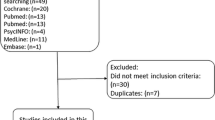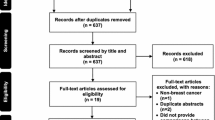Abstract
Purpose Breast cancer patients with treatment-induced menopause experience frequent and severe hot flashes (HF). We compared venlafaxine and clonidine for the treatment of HF with regard to side effects, efficacy, quality of life and sexual functioning. Methods In a double-blind, cross-over study, 60 breast cancer patients experiencing HF were randomized to 8 weeks venlafaxine followed by 2 weeks wash-out, and 8 weeks clonidine or vice versa. HF frequency and severity, side effects, quality of life and sexuality were assessed. Results Thirty patients started with venlafaxine and 30 with clonidine. Premature discontinuation for toxicity occurred in 14/59 during venlafaxine and 5/53 during clonidine (P = .038). Venlafaxine induced more side effects. Median reduction in HF score was 49% for venlafaxine and 55% for clonidine (ns). Conclusion Venlafaxine and clonidine are equally, but moderately effective in HF reduction. Side effects are the main reason for drug discontinuation, occurring more often with venlafaxine.


Similar content being viewed by others
References
Mourits MJ, Bockermann I, De Vries EG et al (2002) Tamoxifen effects on subjective and psychosexual well-being, in a randomised breast cancer study comparing high-dose and standard-dose chemotherapy. Br J Cancer 86:1546–1550. doi:10.1038/sj.bjc.6600294
Stein KD, Jacobsen PB, Hann DM et al (2000) Impact of hot flashes on quality of life among postmenopausal women being treated for breast cancer. J Pain Symptom Manage 19:436–445. doi:10.1016/S0885-3924(00)00142-1
Carpenter JS, Andrykowski MA, Cordova M et al (1998) Hot flashes in postmenopausal women treated for breast carcinoma: prevalence, severity, correlates, management, and relation to quality of life. Cancer 82:1682–1691. doi:10.1002/(SICI)1097-0142(19980501)82:9<1682::AID-CNCR14>3.0.CO;2-0
Couzi RJ, Helzlsouer KJ, Fetting JH (1995) Prevalence of menopausal symptoms among women with a history of breast cancer and attitudes toward estrogen replacement therapy. J Clin Oncol 13:2737–2744
Loprinzi CL, Barton DL, Rhodes D (2001) Management of hot flashes in breast-cancer survivors. Lancet Oncol 2:199–204. doi:10.1016/S1470-2045(00)00289-8
Nystedt M, Berglund G, Bolund C et al (2000) Randomized trial of adjuvant tamoxifen and/or goserelin in premenopausal breast cancer-self-rated physiological effects and symptoms. Acta Oncol 39:959–968. doi:10.1080/02841860050215945
Bines J, Oleske DM, Cobleigh MA (1996) Ovarian function in premenopausal women treated with adjuvant chemotherapy for breast cancer. J Clin Oncol 14:1718–1729
Beral V (2003) Breast cancer and hormone-replacement therapy in the Million Women Study. Lancet 362:419–427. doi:10.1016/S0140-6736(03)14596-5
Rossouw JE, Anderson GL, Prentice RL et al (2002) Risks and benefits of estrogen plus progestin in healthy postmenopausal women: principal results from the Women’s Health Initiative randomized controlled trial. JAMA 288:321–333. doi:10.1001/jama.288.3.321
Carpenter JS, Storniolo AM, Johns S et al (2007) Randomized, double-blind, placebo-controlled crossover trials of venlafaxine for hot flashes after breast cancer. Oncologist 12:124–135. doi:10.1634/theoncologist.12-1-124
Goldberg RM, Loprinzi CL, O’Fallon JR et al (1994) Transdermal clonidine for ameliorating tamoxifen-induced hot flashes. J Clin Oncol 12:155–158
Loprinzi CL, Kugler JW, Sloan JA et al (2000) Venlafaxine in management of hot flashes in survivors of breast cancer: a randomised controlled trial. Lancet 356:2059–2063. doi:10.1016/S0140-6736(00)03403-6
Laufer LR, Erlik Y, Meldrum DR et al (1982) Effect of clonidine on hot flashes in postmenopausal women. Obstet Gynecol 60:583–586
Pandya KJ, Raubertas RF, Flynn PJ et al (2000) Oral clonidine in postmenopausal patients with breast cancer experiencing tamoxifen-induced hot flashes: a University of Rochester Cancer Center Community Clinical Oncology Program study. Ann Intern Med 132:788–793
Barton D, La VB, Loprinzi C et al (2002) Venlafaxine for the control of hot flashes: results of a longitudinal continuation study. Oncol Nurs Forum 29:33–40. doi:10.1188/02.ONF.33-40
Loprinzi CL, Pisansky TM, Fonseca R et al (1998) Pilot evaluation of venlafaxine hydrochloride for the therapy of hot flashes in cancer survivors. J Clin Oncol 16:2377–2381
Barton DL, Loprinzi CL, Quella SK et al (1998) Prospective evaluation of vitamin E for hot flashes in breast cancer survivors. J Clin Oncol 16:495–500
Loprinzi CL, Michalak JC, Quella SK et al (1994) Megestrol acetate for the prevention of hot flashes. N Engl J Med 331:347–352. doi:10.1056/NEJM199408113310602
Carpenter JS, Johnson D, Wagner L et al (2002) Hot flashes and related outcomes in breast cancer survivors and matched comparison women. Oncol Nurs Forum 29:E16–E25. doi:10.1188/02.ONF.E16-E25
Ware JE, Snow KK, Kosinski M et al (2000) SF-36 Health Survey: Manual and Interpretation Guide. QualityMetric Incorporated, Lincoln
Thirlaway K, Fallowfield L, Cuzick J (1996) The sexual activity questionnaire: a measure of women’s sexual functioning. Qual Life Res 5:81–90. doi:10.1007/BF00435972
Zung WW (1965) A self-rating depression scale. Arch Gen Psychiatry 12:63–70
Sloan JA, Loprinzi CL, Novotny PJ et al (2001) Methodologic lessons learned from hot flash studies. J Clin Oncol 19:4280–4290
Loibl S, Schwedler K, von MG et al (2007) Venlafaxine is superior to clonidine as treatment of hot flashes in breast cancer patients- a double-blind, randomized study. Ann Oncol 18:689–693. doi:10.1093/annonc/mdl478
Evans ML, Pritts E, Vittinghoff E et al (2005) Management of postmenopausal hot flushes with venlafaxine hydrochloride: a randomized, controlled trial. Obstet Gynecol 105:161–166
Group Early Breast Cancer Trialists’ Collaborative (1998) Tamoxifen for early breast cancer: an overview of the randomised trials. Lancet 351:1451–1467. doi:10.1016/S0140-6736(97)11423-4
Barron TI, Connolly R, Bennett K et al (2007) Early discontinuation of tamoxifen: a lesson for oncologists. Cancer 109:832–839. doi:10.1002/cncr.22485
Demissie S, Silliman RA, Lash TL (2001) Adjuvant tamoxifen: predictors of use, side effects, and discontinuation in older women. J Clin Oncol 19:322–328
Lash TL, Fox MP, Westrup JL et al (2006) Adherence to tamoxifen over the five-year course. Breast Cancer Res Treat 99:215–220. doi:10.1007/s10549-006-9193-0
Keltner NL, McAfee KM, Taylor CL (2002) Mechanisms and treatments of SSRI-induced sexual dysfunction. Perspect Psychiatr Care 38:111–116
Montejo-Gonzalez AL, Llorca G, Izquierdo JA et al (1997) SSRI-induced sexual dysfunction: fluoxetine, paroxetine, sertraline, and fluvoxamine in a prospective, multicenter, and descriptive clinical study of 344 patients. J Sex Marital Ther 23:176–194
Jin Y, Desta Z, Stearns V et al (2005) CYP2D6 genotype, antidepressant use, and tamoxifen metabolism during adjuvant breast cancer treatment. J Natl Cancer Inst 97:30–39
Author information
Authors and Affiliations
Corresponding author
Additional information
C. Buijs and C. H. Mom have contributed equally.
Rights and permissions
About this article
Cite this article
Buijs, C., Mom, C.H., Willemse, P.H.B. et al. Venlafaxine versus clonidine for the treatment of hot flashes in breast cancer patients: a double-blind, randomized cross-over study. Breast Cancer Res Treat 115, 573–580 (2009). https://doi.org/10.1007/s10549-008-0138-7
Received:
Accepted:
Published:
Issue Date:
DOI: https://doi.org/10.1007/s10549-008-0138-7




